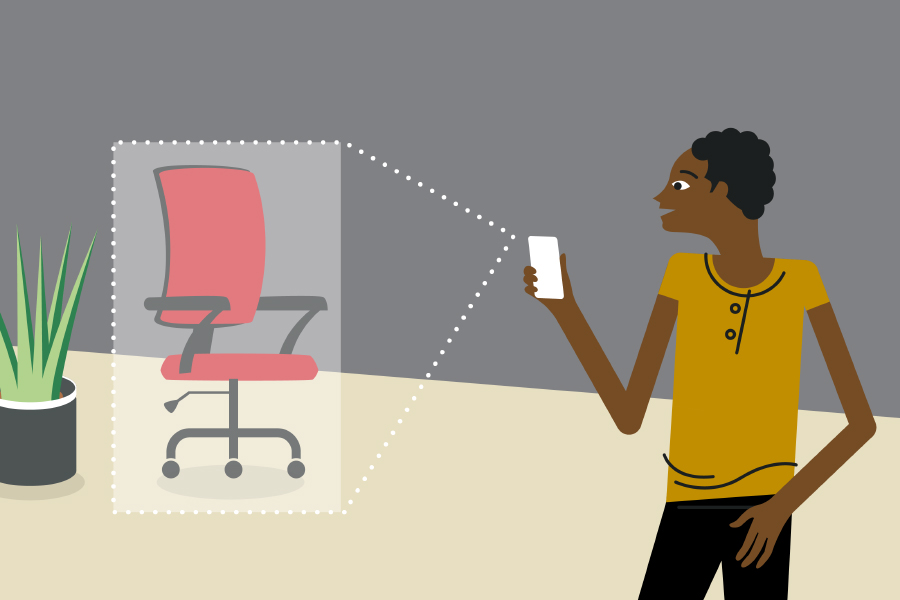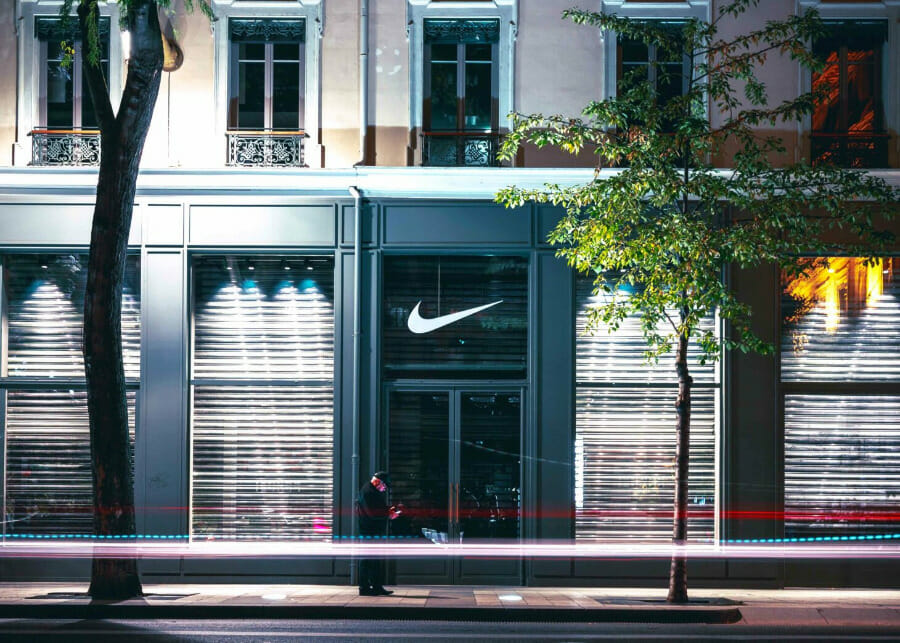Logistics
Industries
Technology & Innovations
E-commerce
E-commerce Fulfillment Services
Lease & Maintenance
Semi Trucks
Logistics
E-commerce
Lease & Maintenance
Buy Used Trucks

[Updated post from February 23, 2021]
Augmented reality. It sounds high-tech, complicated, and expensive. But there’s every chance you’ve already used it, along with the 81.3 million Americans who are using AR on a monthly basis.
While social media filters from the likes of Snapchat or immersive games like Pokemon Go are likely what spring to mind, augmented reality technology today is less of a gimmick, and more of a powerful toolkit to assist both offline and online shoppers with navigating an increasingly complex retail landscape.
But what exactly is augmented reality, and how it is changing the way customers shop online?
Augmented reality (AR) refers to immersive technologies that blend the real-life environment with virtual elements to enhance customer engagement with an app or platform.
Although associated primarily with online shopping, augmented reality is playing a growing role within brick and mortar stores and activations that take place in an offline setting.
AR assists merchants with adding another layer of value-added touchpoints to the shopping journey. As consumer expectations grow for a more interesting and interactive shopping experience, augmented reality tools are enabling customers to gain a better understanding of product offerings while being immersed in brand storytelling.
AR and VR share several crossovers under the broader umbrella of extended reality (XR) technology, but their applications to the shopping journey are very different.
While augmented reality overlays filters and content on top of the shopper's own environment, virtual reality generates an entirely artificial world for the user to navigate and explore via a headset. In sum, VR is designed to take people away from the 'real world', while AR experiences aim to enhance what is already there.
For the majority of brands, augmented reality is a much more accessible form of technology because it doesn't require the same level of hardware or safety protocols as VR does. In most cases, participating in an AR experience only requires a smartphone and access to a specific app, making it much easier for brands to implement.
The growing availability of AR applications in offline and online shopping experiences is playing a major role in the development of the metaverse. This shared virtual reality is pulling together innovations including blockchain, cryptocurrency, and social commerce to create the ultimate digital immersive experience - but it's augmented reality that holds the key to bridging the gap between shoppers' online and offline retail activities.
The hybrid nature of AR is allowing greater numbers of consumers to carry a fragment of the metaverse with them wherever they go, ready to tap into brands' latest creations and innovations within the comfort of their own homes or inside a storefront.
By enabling customers to interact with product offerings, user manuals, and marketing campaigns more effectively within both physical and digital spaces, augmented reality is allowing for more purpose-driven shopping experiences that span multiple channels.
It's common for shoppers to have dramatically different experiences between e-commerce and brick and mortar - even when shopping with the same brand. Thanks to online shopping springing up as an entirely separate division for many legacy retailers, this has resulted in rigid, siloed experiences, leaving consumers unable to move seamlessly between channels as they see fit.
This is a particular challenge when digital and physical selling channels each have their own pros and cons. Brick and mortar allows consumers to interact with products freely, but is tied to a particular time and place. While online stores allow customers to shop entirely on their terms, it requires them to take a risk on untried or untested products.
AR tools assist brands with bringing the essence of the in-store experience to the e-commerce customer journey - and vice versa - offering customers unparalleled flexibility in how they interact with products and make purchasing decisions.
High return rates are a persistent problem in e-commerce. When customers are unable to effectively test or try products before purchasing, the only option is to do your research and hope for the best. As a result, many customers end up returning products due to incorrect sizing - or simply because they looked different in a real environment compared with online.
Augmented reality enables brands to reduce return rates by allowing customers to virtually ‘try’ a product within the context of their own home, or even on their own face and body via AR filters. This gives consumers more confidence that their purchasing decision is the right one.
A study from last year by Apple found that consumers are 11 times more likely to buy furniture if they can use AR first to see how it looks within their home. Moreover, the 2021 State of Returns survey found that 58% of consumers who use AR believe these tools have prevented them from having to make a return. Another 32% of consumers would use AR and tech try-on tools if made available.
In sum, AR helps consumers to avoid unsuitable purchases that will ultimately bounce back into your warehouse.
The concept of ‘value’ is often tricky for brands to define; it’s an intangible ‘something extra’ that creates a satisfying customer experience. Value is what persuades consumers to choose you over competitors, and what turns first-time buyers into loyal repeat customers.
Augmented reality technology is a key indicator of value because it offers consumers a powerful set of tools to assist their purchasing decisions. In fact, studies show that consumers are willing to pay as much as 40% more for a product that can be ‘tried’ through AR!
This isn't because augmented reality makes a product perform better; it's because AR apps and portals enable customers to experience products in an entirely new way. The more capabilities you have in your toolkit, the easier it is to boost your customer's perception of value.
When consumers feel confident about purchasing from you, they're much more likely to shop again in the future and recommend you to others. Augmented reality technology helps to boost consumer trust because it's a wise investment in the customer experience. By removing friction with the shopping journey and making it easier than ever to make informed purchasing decisions, the pathway to making a repeat purchase is seamless.
While implementing augmented reality can feel like a pipe dream for many brands, the global AR and VR market is heating up fast. Valued at $16.92 billion globally in 2021 and forecast to reach $105.67 billion by 2028, we're seeing the steady expansion of AR across a range of product categories as offline and e-commerce retailers alike battled to retain customers during COVID-19
AR technology offered retailers a wealth of ways to bring more immersive experiences to e-commerce during the height of the pandemic. It gives omnichannel and multichannel retailers – unable to serve their customers in physical channels – a new set of tools to remove friction from the online shopping experience. From virtual try-on solutions to AR filters that enable shoppers to 'place' items within their home environment, augmented reality has been invaluable over the past couple of years of disruption.
The stats don’t lie; consumers have loved having augmented reality as a feature of the online shopping experience. Over half of consumers (61%) say they prefer to make purchases from sites that incorporate AR technology. As more consumers utilize mobile to search for product information and pricing, AR is a natural extension of the mobile shopping journey that consumers have been quick to adopt.
But with the acute phase of the pandemic now over and consumers flocking back to retail shops, what does this mean for augmented reality in 2022 and beyond?
After two years of stratospheric growth, it's clear that the momentum of e-commerce is starting to slow down. March 2022 marked the first month since the pandemic that online sales declined while brick and mortar sales rose - a clear sign that shoppers are navigating a retail future that is increasingly hybrid.
But this doesn't mean that augmented reality will play any less of a role; in fact, evidence suggests that AR has just as many applications in the physical world of retail as it does online. It's clear that customers think so too: A study by Snapchat found that three-quarters of consumers believe that AR technology will influence how people shop over the next five years, while 57% claim that they will increase their use of AR after the pandemic.
So, what will augmented reality look like in an increasingly omnichannel retail environment?
With consumers relying on e-commerce to buy larger, more complex items such as furniture and appliances, augmented reality is helping consumers to preview products within the context of their own homes before purchasing.
AR apps enable both online and in-store shoppers to make better-informed purchasing decisions by bringing together their real-world environment and immersive digital information to give more context to a product. It brings a more hands-on dimension to digital shopping, while also giving shoppers another tool to assess products before making a visit to a store location to check out a product in-person.
IKEA was one of the earliest adopters of AR technology via the IKEA Place app, which allows customers to visualize furniture and other products within their home from different angles. However, they aren't the only home decor brand that has embraced AR to give the edge; Amazon's app also offers the Amazon View functionality, where customers can select the 'View in Your Room' tool to place any Amazon products within their own surroundings.
Consumers shopping for apparel or cosmetics face the most difficulty when it comes to ‘trying’ garments or products in advance. Getting to style and experiment with different looks and products, often with the assistance/recommendations of store associates, has long been a key part of the buying journey. But testers have been largely abandoned by brands during the pandemic due to hygiene concerns, making it more challenging for both in-store and e-commerce customers to purchase products with confidence.
The increasing sophistication of AR technology has opened up new opportunities to engage with shoppers via virtual try-on tools. A twist on the beautifying social media filters we've gotten to know on Instagram Stories, try-on filters are assisting both existing and new customers with exploring different products - without the commitment of making a purchase or visiting a store location.
Sephora’s Virtual Artist AR app allows beauty enthusiasts to try out cosmetics from a variety of brands via its advanced facial recognition software, which ensures the correct placement of lipstick and eyeshadow and adjusts for a variety of skin tones. This is also integrated with interactive tutorials with tips on how to apply different products to maximize their effect.
Warby Parker is another brand that has made virtual try-ons a core part of its value proposition. Once a digitally-native retailer, their try-on feature was integral to giving consumers the confidence to purchase glasses without viewing them in person. Now with store locations across the U.S., augmented reality is no less important to the brand. Virtual try-on solutions are assisting Warby Parker with introducing consumers to their product and driving traffic in-store; in fact, half of their sales now take place offline.
With a growing number of consumers now embracing a return to brick and mortar, there's been a resurgence of interest in the applications of AR in offline settings. With shoppers now gravitating toward experiential retail set-ups that embrace new technology and gamification, augmented reality offers brands the ability to create a fresh take on post-pandemic retail and events.

Nike's House of Innovation in New York City has long been a vehicle to pioneer experimental retail activations. In January 2021, they launched an AR-enabled, socially-distanced discovery journey for the launch of its All Conditions Gear (ACG) HO20 collection. Through the use of QR codes and AR markers, consumers navigate a digital 'base camp' with a variety of challenges to learn more about the collection and local wildlife in exchange for free merchandise.
Snapchat, arguably the birthplace of mainstream AR, has also been hard at work bringing immersive experiences to live events. Their recent partnership with Live Nation will allow concert-goers to use the Snapchat app to enable AR experiences in real-time, including trying on merchandise, finding friends, and unlocking additional branded content.
One of the biggest advantages that e-commerce has bought to consumers is the ability to perform extensive product research from the comfort of our own homes. With the power of online search, shoppers are able to evaluate and compare multiple product options without the assistance of brand representatives.
Thanks to growing smartphone penetration, consumers are increasingly bringing these research and discovery capabilities in-store; 34% of shoppers used smartphones to assist them with in-store shopping in 2021 - up from 28% in 2020.
These changing shopping behaviors are key to the growing adoption of AR in-store. The real-world environment can offer significant limitations when it comes to product information, with packaging only able to hold a finite amount of details. Augmented reality is offering brands a way to extend the presence of a product through instructional videos, interactive user manuals, and other forms of brand storytelling to drive purchases.

Jack Daniels built a unique AR activation that offered customers the ability to virtually tour the distillery and learn about the end-to-end distillation experience by scanning the bottle's label about the Jack Daniels AR app. Fans also get to learn more about the origins of the iconic brand and how it came to be, getting them as close as possible to their favorite drink.
The ability of AR to build immersive experiences offers brands a major competitive advantage in their marketing efforts - by allowing consumers to play a pivotal role in the brand story. The continuing novelty of AR activations is enabling brands to extend their reach beyond their existing customer base, which is invaluable for brand awareness campaigns.
With social media platforms already investing big in their own AR technology, this is opening up new opportunities for merchants to reduce development time and leverage consumers' existing social media habits.
The coffee giant Starbucks cleverly decided to poke fun at its extensive menu in 2020 by launching an Instagram filter called ‘Which Drink?”. This digital content campaign helped customers to find the perfect beverage by randomly selecting a Starbucks drink for them when the filter was activated. Starbucks also encouraged drinkers to use the feature within store locations to find inspiration and experiment with different products, meaning higher sales and more positive in-store experiences.

As consumers adopt an increasingly hybrid approach to retail in the aftermath of the pandemic, augmented reality is set to play a larger role in bridging the gap between the offline and online shopping experiences. AR technology is becoming more advanced in its applications, as shown by the growing popularity of virtual try-on and product visualization tools, in addition to being more accessible to merchants large and small. As the uptake of AR during the shopping journey increases, brands face growing expectations for immersive experiences.
One thing's for sure: Augmented reality is a growing space that all brands should be keeping an eye on.